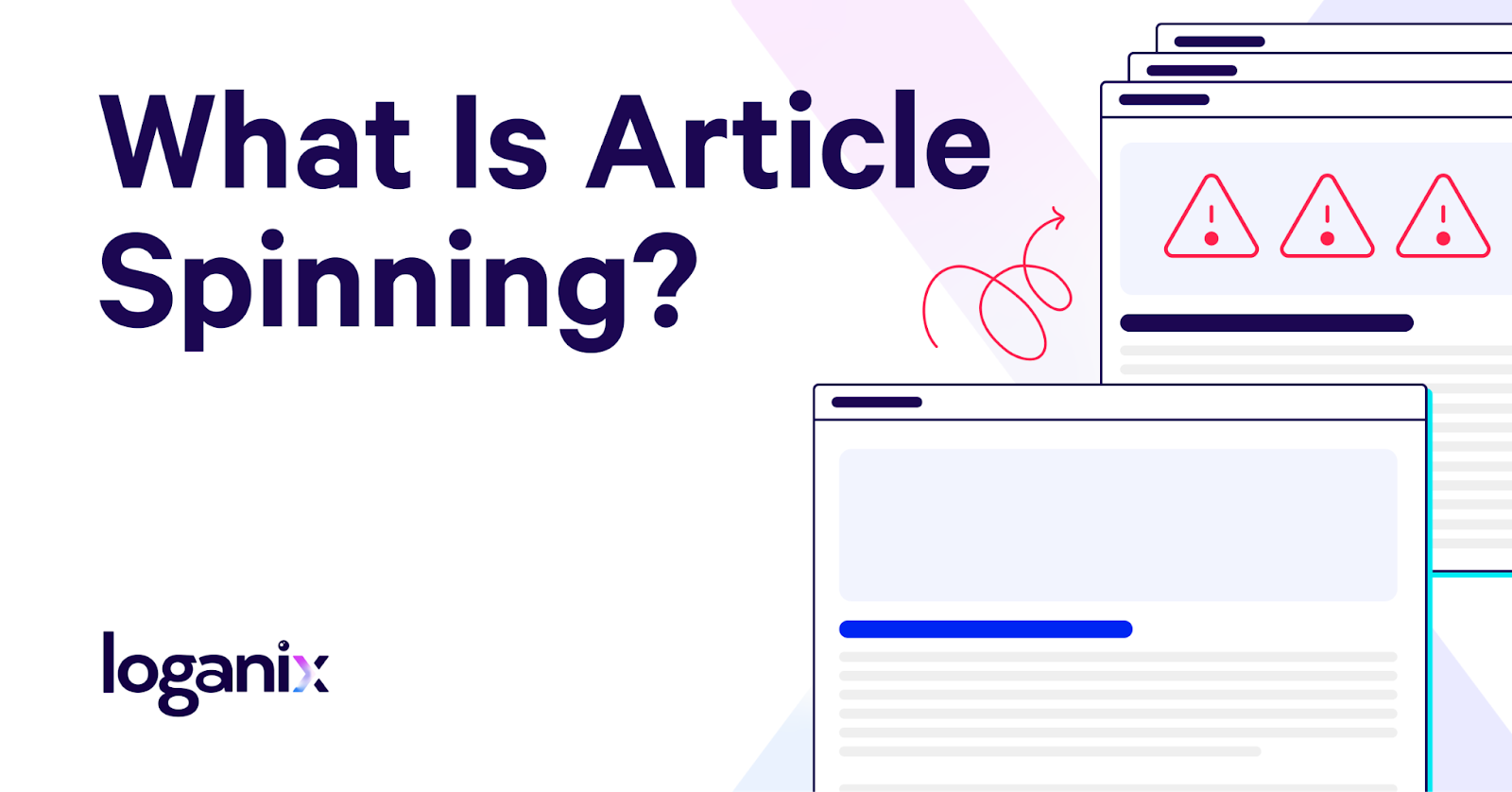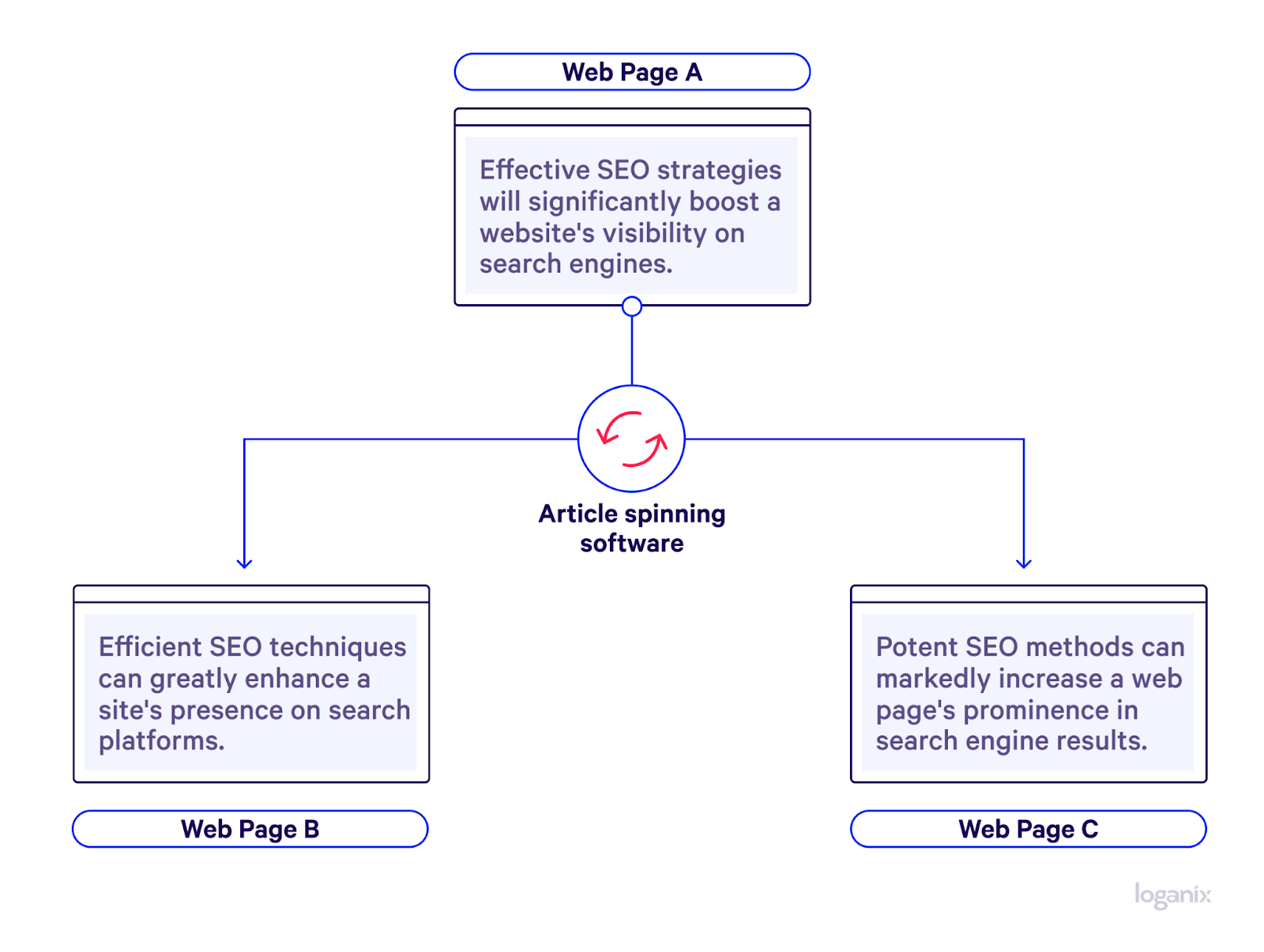What Is Article Spinning? The SEO Implications of Spun Content

Hand off the toughest tasks in SEO, PPC, and content without compromising quality
Explore ServicesTo appease the algorithm gods with “freshness,” many creators feel the pinch and resort to shortcuts. For smaller creators, it often feels like the only way to compete with the big players.
Regardless of these challenges, is article spinning really the right direction to take a content marketing campaign?
Let’s find out. By the end of this guide, you’ll
- have the answer to the question, “What is article spinning?”
- understand the potential pitfalls and implications of this approach,
- and discover how you can recognize spun content.
What Is Article Spinning?

Article spinning is the act of taking existing content—whether that be an article, blog post, or any other written material—and, typically with the assistance of spinning tool software, altering its wording, sentences, and paragraphs. The goal? To produce multiple “new” pieces of content in a fraction of the time.
You might be thinking that article spinning sounds the same as rewriting or paraphrasing. So, what’s the difference?
While both involve taking inspiration from the original text, the intent behind article spinning is to generate bulk content quickly, particularly for search engine optimization (SEO) purposes. Contrastingly, genuine rewriting aims to improve clarity, update outdated information, and add nuances or fill in any oversights or gaps that exist in the original content—all while maintaining originality and authenticity.
Learn more: Interested in broadening your SEO knowledge even further? Check out our SEO glossary, where we’ve explained over 250+ terms.
Is Article Spinning Bad for SEO?
The short answer is yes. Search engines like Google have become adept at spotting and sidelining “spun” content, meaning article spinning isn’t conducive to search engine optimization best practices.
Let’s break down in more detail exactly why.
Search Engines and Spun Content
Sure, advancements in technology and artificial intelligence (AI) may make it easier to spin content. The thing is, it also makes it easier to detect. With continued improvements and sophistication, search engine algorithms have become incredibly adept at detecting content spinning.
How? Content written by content-spinning software follows probability patterns, making it relatively easy for plagiarism tools and search algorithms to detect.
From a reader’s viewpoint, spun content misses the depth and authenticity of a skilled writer. This will deter a target audience, increase bounce rates, reduce time on page, and negatively impact ranking metrics that search engines use to assess the value of a page.
The Penalties for Taking Shortcuts
Websites relying heavily on content spinning risk falling afoul of Google’s algorithms, like Panda, that specifically target and downgrade low-quality content.
The company makes it pretty clear in its spam policy. Google classifies article spinning as “scrapped content” and defines it as “Sites that copy content from other sites, modify it only slightly (for example, by substituting synonyms or using automated techniques), and republish it.”
What are the repercussions of going against the spam policy? Risking a significant drop in search rankings, reduced web traffic, and, in severe cases, a possible manual action that could lead to de-indexing. It’s a truly high price to pay for a shortcut that may not even work in the first place.
Trust and Credibility
Beyond the SEO implications, there’s a more insidious impact of spun content. We touched on it: harm to user experience and an erosion of trust. Readers are savvy—they can sense when content feels off, lacks authenticity, or feels rehashed. It’s really not worth the risk because once trust is lost, regaining it is an uphill battle. A website’s credibility takes a hit, and with it, the chances of visitors returning or converting into loyal customers diminish.
Ethical and Legal Implications of Article Spinning
Article spinning raises several ethical and legal questions that every content creator should consider.
The Ethical Quandary
When it comes down to it, article spinning is really about producing content rather than creating it. Ethically, it’s a murky territory. While the words may vary, the ideas and structure are essentially the same. There is no value added. This begs the question: is it right to present spun content as original, especially when the primary intent is to deceive search engines and, by extension, readers? Probably not.
Is Article Spinning Legal?
Ethics aside. Legality is a different beast. If you’re spinning someone else’s content without permission, you’re possibly infringing on copyright laws. Even if the words are changed, the underlying ideas and structure can still be protected.
So, what about your own content? Surely you can’t spin that, right? Technically, you’re not infringing on anyone’s rights, but you’re still walking a fine line. While it might be legal, because of how good search algorithms have become at detecting article spinning, it’s not beneficial in the long run.
Identifying and Differentiating Spun Content
There are often tell-tale signs of spun content. Let’s dig into what they are.
Unnatural Flow
Genuine human writing has a rhythm and flow to it. Spun content, on the other hand, often feels disjointed or awkward. It lacks the natural progression of ideas that a human writer would provide.
Odd Word Choices
Spinning tools often replace words with synonyms, but these replacements don’t always make sense in context, leading to odd phrasings or terms that feel out of place.
Inconsistencies in Tone and Style
Tone and style inconsistency is a tell-tale sign of spun content. While a human writer maintains a consistent tone throughout an article, spun content can fluctuate, sounding formal in one sentence and casual in the next.
Lack of Depth
Spun articles often lack depth and nuance. It’s fluffy and feels like a lot is being said without much being said at all. So, they might touch on a topic but fail to delve into it meaningfully, giving readers a sense of superficiality.
Article Spinning FAQ
Q1: What Is an Example of an Article Spinning?
Answer: Let’s run through a clear example of article spinning.
Original Content: “Digital marketing is an essential aspect of modern business. With the rise of online platforms, companies must adapt and find innovative ways to reach their target audience.”
Spun Content: “Online promotion is a crucial part of contemporary commerce. With the growth of digital channels, enterprises must adjust and discover novel methods to connect with their desired audience.”
See the problem? If a website visitor were to read one paragraph on one web page, jump out, click on the below search result, and then read the second paragraph, they’d probably feel a sense of déjà vu.
Q2: How Do You Rewrite an Article Without Plagiarizing?
Answer: To rewrite an article without plagiarizing, grasp the core ideas of a content piece, and express them in your unique voice and perspective rather than just rewording the article. Always cross-check your rewritten content with plagiarism detection tools and ensure you’ve added value, depth, and a fresh perspective to the topic, not just regurgitating what’s already published.
Conclusion and Next Steps
Authenticity, originality, and value-driven content are the cornerstones of a successful content marketing strategy.
From expert blog writing that resonates with your audience to niche edits that enhance your existing content and comprehensive content marketing services that drive results, Loganix has got you covered.
🚀 Discover the full range of Loganix’s services and take the next step toward content excellence. 🚀
Hand off the toughest tasks in SEO, PPC, and content without compromising quality
Explore ServicesWritten by Aaron Haynes on November 22, 2023
CEO and partner at Loganix, I believe in taking what you do best and sharing it with the world in the most transparent and powerful way possible. If I am not running the business, I am neck deep in client SEO.





